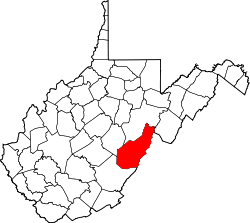Droop | |
|---|---|
| Coordinates: 38°5′6″N80°17′5″W / 38.08500°N 80.28472°W | |
| Country | United States |
| State | West Virginia |
| County | Pocahontas |
| Time zone | UTC-5 (Eastern (EST)) |
| • Summer (DST) | UTC-4 (EDT) |
| ZIP codes | 24933 |
Droop is an unincorporated community in Pocahontas County, West Virginia, United States, in the Greenbrier River Valley[ citation needed ].
Contents
The community takes its name from nearby Droop Mountain. [1] The area lends its name to Droop Mountain Battlefield State Park, site of West Virginia's last significant Civil War battle. [2] The Civilian Conservation Corps (CCC) constructed the park's trails and buildings in the 1930s, as part of Franklin D. Roosevelt's New Deal legislation[ citation needed ]. Today, a small museum on the park grounds houses Civil War artifacts and discusses the park's CCC history. [3] Bi-annually, the West Virginia Reenactors Association reenacts the Droop Mountain battle. [4]
- Snowy Day at Droop Mountain
- Overlook at the Park




